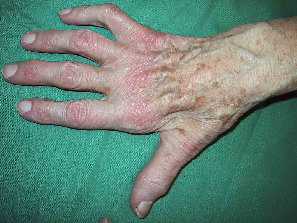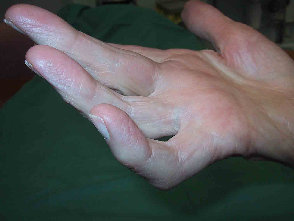What is cubital tunnel syndrome?
Cubital tunnel syndrome is compression of the ulnar nerve as it passes through the cubital tunnel.
The ulnar nerve is a major nerve supplying sensation in the little and ring fingers plus many of the small muscles in the hand. This nerve is commonly compressed at the elbow, and less commonly at the wrist. Compression of the nerve as it passes through a tunnel behind the elbow (the cubital tunnel) is called cubital tunnel syndrome.
Symptoms:
The symptoms that patients usually experience are of altered sensation in the hand or of muscle weakness. The typical symptoms are:
-
altered feeling, pins and needles or tingling in the little and/or ring fingers.
-
pain in these fingers which may can radiate up the forearm.
-
weakness of the small muscles in the hand usually presenting with difficulty opening jars or gripping items.
-
visible loss of bulk (wasting) of the muscles in the hand (
figure 1)
 Figure 1: wasting of the small muscles in the hand
Figure 1: wasting of the small muscles in the hand
-
'clawing' of the little and ring fingers - the fingers are held slightly flexed. Passively the movement is normal (
figure 2)
 Figure 2: Typical appearance of an 'claw' hand
Figure 2: Typical appearance of an 'claw' hand
Initially, these symptoms are intermittent but in more advanced cases the fingers may be permanently numb with little feeling. The symptoms are often worse if the elbow is flexed, such as when using the telephone, driving a car or when in bed. Some patients wake with numbness and tingling in the little and ring fingers during the night or first thing in the morning.
In most cases your doctor will make the diagnosis after a physical examination. It may be necessary to arrange further investigation with nerve conduction studies. These are painless electrical tests which help to identify the site of the nerve compression. Occasionally compression of nerves in the neck or shoulder can mimic the symptoms of cubital tunnel syndrome, but the nerve conduction studies will usually distinguish between them.
Treatment:
Non-operative: This relies upon appreciating that the ulnar nerve lies in a tunnel behind the elbow joint and as the elbow flexes, the nerve becomes stretched. If the nerve is compressed in the cubital tunnel, elbow flexion may precipitate symptoms.
Nerve protection: Patients are advised to keep the elbow straight as often as possible and to avoid flexing and leaning on the elbow. Answering the telephone with the unaffected hand or using a hands-free device can be helpful.
Soft night-time elbow splint: This can help control night-time symptoms and it is useful in some patients. (I regularly use a splint on my own cubital tunnel syndrome with good results!).
Surgical treatment: is indicated for those patients whose symptoms do not respond to non-operative treatment. Surgery involves releasing the ulnar nerve from its tight cubital tunnel behind the inside of the elbow. There is debate amongst surgeons as to whether anything further should be done to the nerve, such as moving it to the front of the elbow (referred to as an anterior transposition). If the nerve is transposed, it can be left in the fatty tissue beneath the skin (subcutaneous anterior transposition) or moved beneath the big mass of muscles (submuscular anterior transposition). Each surgeon has their preferences, mine is to perform a simple in-situ ulnar nerve release, and only transpose it anteriorly if the nerve is unstable afterwards.
Other surgical treatments have been described, include excising the medial epicondyle of the humerus. You will need to discuss which procedure is best for you with your surgeon. Surgery can be performed using either general or regional anaesthesia as a day case procedure. In regional anaesthesia you will be awake but your arm will be paralysed and numb for several hours. The choice will depend upon the patient's wishes and anaesthetists preferences. Post-operatively there will be a bulky bandage around the elbow and the stitches remain for 2 weeks.
Results of surgery:
The outcome of surgery depends upon several factors, including the severity of the presenting cubital tunnel syndrome. Muscle wasting is often irreversible and it is best to treat the condition before it becomes this severe.